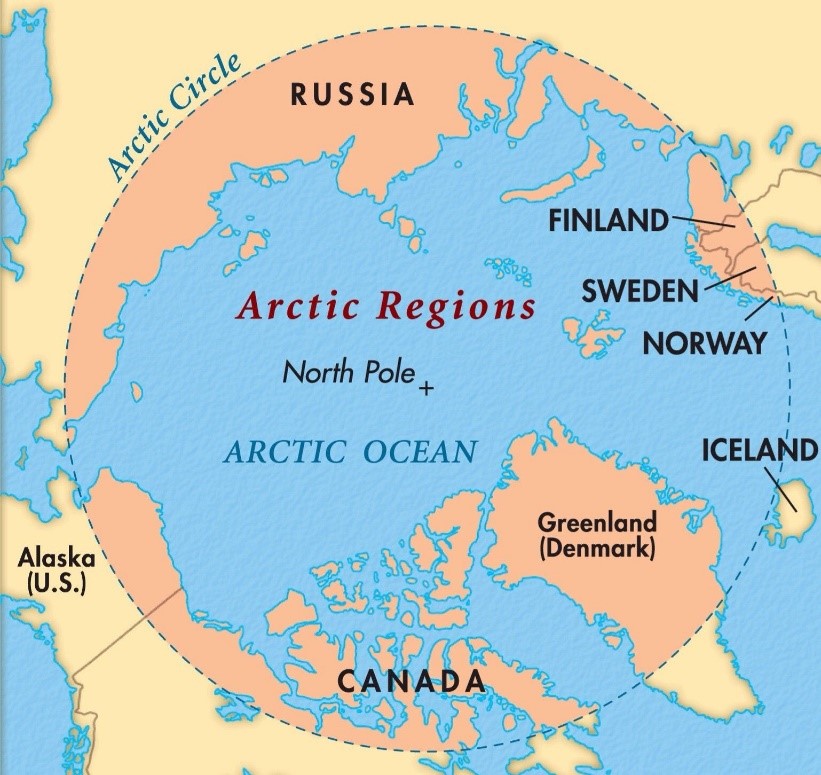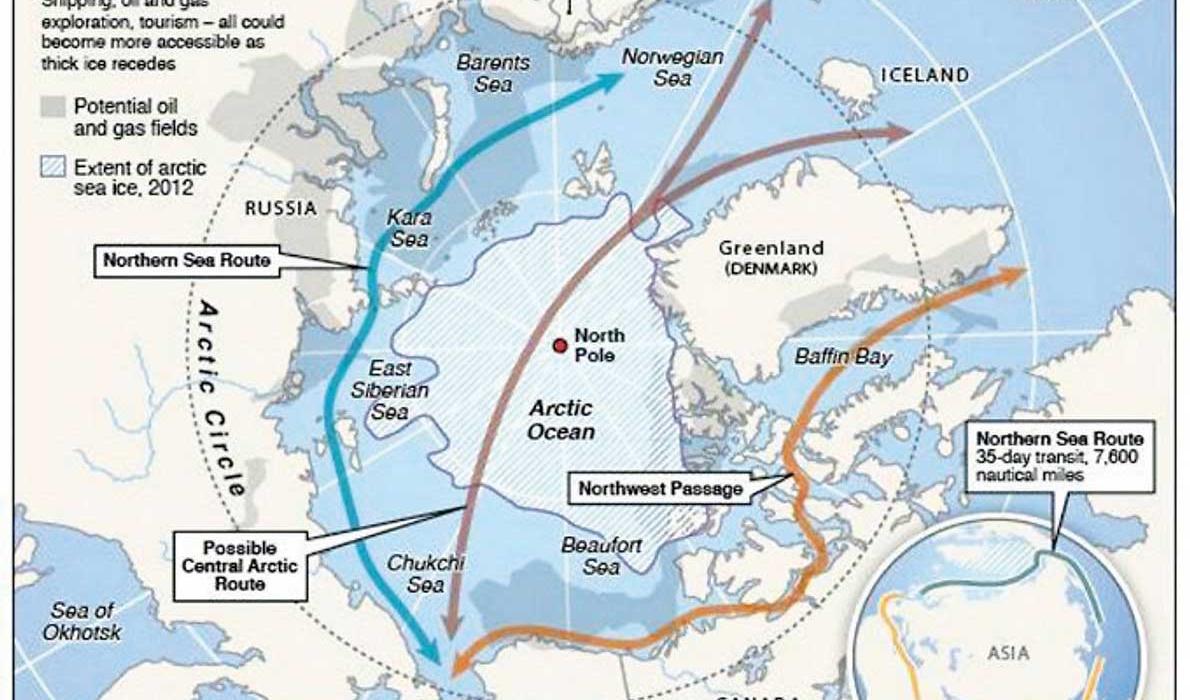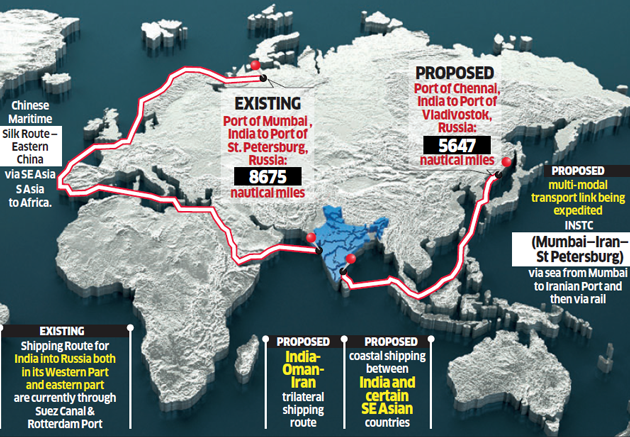India and the Arctic region
2020 JUN 11
Mains >
International relations > India and Global Regions > Global research projects and India

IN NEWS:
- Russia declared a state of emergency after a fuel leak in its Arctic region caused 20,000 tons of diesel oil to escape into a local river called Ambarnaya.
- The power plant is located near Norilsk city, around 3000 km northeast of Moscow, near the vast and sparsely populated Siberian peninsula.
RELATED ISSUE:
- Significance of Arctic region; India’s Arctic potential;
THE ARCTIC REGION:
- The Arctic region, or the Arctic, is a geographic region spreading around the North Pole.
- Location: The Arctic Circle (66° 33' N) delimits the Arctic in terms of solar radiation. It consists of the Arctic Ocean, adjacent seas, and parts of Alaska, Northern Canada, Scandinavian countries and Russia.
- Climate: The Arctic's climate is characterized by cold winters and cool summers. The monthly average temperature in the Arctic is below 10 ° C throughout the year.
- Vegetation: Arctic vegetation is composed of plants such as dwarf shrubs, herbs, lichens, and mosses, which all grow relatively close to the ground, forming tundra. Trees rarely grow in the Arctic, but in its warmest parts, shrubs are common and can reach 2m in height.
- Human inhabitations: Only about 4 million people live in the Arctic worldwide. The economy mostly comprises of oil and gas extraction, fishing and tourism.
- Aurora: Also called the northern lights, the aurora borealis appear in the sky on clear, dark nights during periods when solar storms are active. The aurora borealis is centered around the geomagnetic North Pole and is most often seen above the Arctic Circle.
SIGNIFICANCE OF ARCTIC REGION:
- Influence on global climate: Arctic is one of the major cryosphere in the world and have a profound impact on the global climate and sea levels. Its permafrost is a major carbon sink which helps regulate the global temperatures.
- Metallic and energy resources: The territories in the Arctic Circle have large minerals, particularly, iron ore, gold, nickel, copper and uranium. Projections show that the area is home to an estimated 13% of Earth's reserves. Also, the explorations are expected to pick up as Arctic shipping develops further in the future.
- Biotic resources: Apart from the minerals, the Arctic regions is also a source of fishing and is often called the ‘kitchen of Europe’. Also, the releases of new lands as a result of melting of ice will lead to potential development of agriculture in the region.
- Navigation: The melting sea ice in the region could potentially open a new trade route from Europe to east Asia. Trial voyages have already begun along the Northern Sea route. Experts say it could reduce the travel distance from east Asia to Europe from the 21,000 kms it takes to go via the Suez Canal, to 12,800 kms.

- Geopolitical: The opening of the new sea routes and the scramble for resources makes for new geopolitics in the region. It could redefine the significance of strategic choke points such as the Suez Canal and Malacca strait. Countries have already started amking inroads into the region. For eg: China has referred to itself as a ‘Near-Arctic state’ in its Arctic Policy and put forth the idea of a ‘Polar Silk Road’ as part of its larger Belt and Road Initiative (BRI).
THE ARCTIC COUNCIL:
- It is the intergovernmental forum that addresses issues faced by the Arctic governments and the indigenous people of the Arctic.
- It comprises of eight countries with sovereignty over the lands within the Arctic Circle: Canada, Denmark, Finland, Iceland, Norway, Russia, Sweden, and the United States.
- Besides these members, there are several countries with observer status, which includes India and China.
- In 2011, the Council clarified its criteria for admission of observers, most notably including a requirement of applicants to "recognize Arctic States' sovereignty, sovereign rights and jurisdiction in the Arctic
CONCERNS OVER ARCTIC REGION:
- Impact of global warming: Over the past 30 years, the Arctic has warmed at roughly twice the rate as the entire globe, a phenomenon known as Arctic amplification. the level of Arctic Sea ice is decreasing by 12.8 percent per decade since 1979; The world’s permafrost holds more carbon than is currently in the atmosphere
- Territorial disputes: While the United Nations Convention on the Law of the Sea (UNCLOS) has been ratified by all Arctic littorals with the exception of the US, climate change is altering the geophysical realities of the Arctic, prompting more intense territorial claims.
- Dispute over ‘global commons’ status: While much of the region’s ocean falls within the recognized national jurisdictions of the Arctic coastal states, some, such as the EU and China, discreetly hopes to make the Arctic part of the global commons. This can result in disputes in the near future.
- No overarching guidelines: Unlike the Antarctic treaty, there are no overarching guidelines on how stakeholders can engage the Arctic’s resources. The Arctic Council, while being the dominant organisation in the region, is more of a political forum that does not have any legal basis. The Council does not discuss military matters and has limited funds. It also lacks broader frameworks to govern matters such as sea routes and resources.
- Increasing accidents: Increase in commercial endeavors, such as petroleum extraction and shipping, will increase the frequency of accidents such as oil spills, as was seen in the 1989 Exxon Valdez oil spill in Alaska and the recent oil spill in Russia. In the highly sensitive Arctic, this could have disastrous consequences.
INDIA’S INVOLVEMENTS IN THE ARCTIC:
- In the absence of an official Arctic policy, India’s Arctic research objectives are centered on ecological and environmental aspects, with a focus on climate change. India, for one, opened Himadri, its only research station in the region in 2008.
- India is an observer state in the Arctic council since 2013.
- In 2018, India displayed an increasing commitment to Arctic research when its National Centre for Antarctic and Ocean Research was renamed the National Centre for Polar and Oceanic Research. India has also established bilateral research cooperation with Norway under the Norwegian Programme for Research Cooperation with India (INDNOR).
- As India currently lacks a Polar-suitable vessel, India has planned to acquire a Rs. 1000 crore Polar Research Vehicle, which will be advantageous in escalating scientific research activity in both the poles.
- Indian firms have made significant investments in the region’s mineral explorations. Eg: India’s Oil and Natural Gas Corporation (ONGC) Videsh Ltd. holds 20% stake in Russia’a Sakhalin-I project.
WHY INDIA NEEDS ARCTIC:
- Expand energy basket: Diversification of energy imports remains a crucial endeavor for India. The Arctic, with its untapped reserves and friendly neighbors, offers an opportunity in this regard.
- Address climate change: India’s environmental concerns are closely intertwined with the region’s climate change concerns in terms of Sea Level Rise. Also, a correlation between Arctic ice-melt and the Indian Monsoons has been established but the exact effect remains undiscovered. The effects of this would be detrimental, specifically on agriculture that remains critical to India’s economy and growing population.
- Potential investments: The iron ore and petroleum deposits in the region offers new areas of investment for Indian mining and petroleum industries. PSUs such as GAIL and ONGC Videsh have already made investments in this regard.
- Export of manpower: Given the increasing discovery of resources and the opening of shipping routes, the need for infrastructural development is consequently increasing. This offers potential collaborations and involvement of skilled Indian labour in infrastructure development such as building ports and other economic activities.
- Strategic benefits: Strong cooperation with the Arctic countries provides an opportunity to expand India’s ‘Act East’ approach. For eg: Linking the coastal city of Chennai to Vladivostok with a maritime route essentially means Russia’s Far East would extend to India as well. This can also help India counter China’s Belt and Road initiative.

- Benefit research activities: Arctic countries are home to some of the top polar research institutions in the world. Collaborations with them can benefit India, not only in its arctic endeavors but also in addressing domestic challenges. For eg: Study and research regarding warming of the arctic will help India to develop an understanding of fast-melting glaciers in the Himalayas, which is referred to as the Third Pole.
CHALLENGES FOR INDIA:
- Geographical barrier: While countries such as China, Japan and South Korea may benefit considerably from connectivity and resources of the region, India is not strategically located to extract commercial advantages of the region.
- Lack of Arctic policy: India does not have an official Arctic policy yet. Its Arctic research objectives are centered on ecological and environmental aspects, with a focus on climate change. An arctic policy can help expand this to areas such as commercial exploitations and strategic cooperation.
- Chinese dominance: China has engaged in energy deals and investments and has taken concrete steps in formulating close ties with certain Arctic countries. China has referred to itself as a ‘Near-Arctic state’ in its Arctic Policy. Hence, the Chinese presence will make it difficult for India to make significant inroads in the region.
- Nascent research programmes: Several research stations in the Arctic are functional all-year-round but India’s research station, Himadri, is not operational in the winter. It is imperative that India improve upon and put in place a more robust Arctic research programme to deal with these future threats.
- Question of global commons: Countries outside the region, including India, are in need of energy, new markets and resources. To this end, countries such as China hopes to make the Arctic global commons a reality. However, taking a similar stance may hamper any progress India has made in the region.
WAY FORWARD:
- The Arctic may be the northernmost part of the world, geographically far from India. However, India cannot remain immune from the developments in the region. In this context, India will have to look at the Arctic- both from the prism of climate change and also as a strategic construct.
- The possibilities are many, but India needs to quickly get its act together before opportunities melt away. An ‘Indo-Arctic policy’ could provide the necessary platform for India. It could open political space for New Delhi to work with like-minded countries to expand its footprint in the Arctic.
- India’s scientific and research activity, although in its early stages in the Arctic could expand given its experience in Antarctica. To strengthen its scientific capacity, India should set up more research stations in the region. It should also procure its long-overdue polar research vessel.
- Cooperation and collaboration with other countries-whether Artic Council members or Observers-should be increased as this will result in the sharing of facilities and expertise, increasing India’s experience and encouraging friendlier relations with those countries.
- India’s position in terms of private sector investment in the region is weak. Here, India should encourage businesses and other interested parties to participate more in the Arctic Circle.
PRACTICE QUESTION:
Q. ‘With the Arctic growing both in environmental and geopolitical relevance, it would be unwise for India to ignore the importance of the region’. In this regard, Discuss the need for an Arctic policy?


